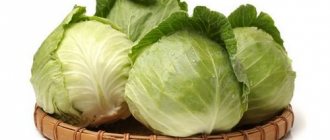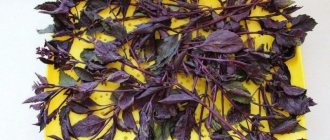Features of storage at home
At home, basil will retain its beneficial properties only if it is of high quality. Therefore, when you bring home a bunch, you need to carefully examine each leaf, check for yellowness, signs of rot and damage. If such specimens are available, they must be removed immediately, otherwise the stock will quickly become unsuitable for human consumption.
There are certain recommendations that must be followed when storing at home:
- greens can be placed in a container of water and placed on the refrigerator door or left at room temperature;
- Plastic bags are used to pack supplies, but in this case, the basil is dried before storage; there should be no traces of moisture on it;
- if you plan to keep it in a bag, make several holes in it;
- Do not tie the bunch with a thread; it is better to store the basil in bulk;
- Before storing in the refrigerator or at room temperature, do not rinse the greens.
If you do not plan to eat the spicy leaves fresh, but take them for cooking, it is better to use improvised preservation methods: pickling in salt water and refined vegetable oil. If the herbs are used only as a dry seasoning, it is better to dry them in the oven or in the sun. In this form, the plant will retain its aroma, but will often lose its beneficial properties.
Attention! The shelf life of fresh basil in the refrigerator is no more than 7 days. At room temperature, placed in a glass of water, it will maintain leaf turgor for 2-3 days.
Main subtleties and nuances
When preparing basil for the winter, certain rules are followed:
- collect the stems of the plant in the morning before the dew leaves, this improves the aroma;
- wash the leaves in cold water, touch each one with your hands to remove all dirt and dust;
- diseased shoots are removed and not used;
- Before harvesting, the raw materials are dried;
- Basil can be stored frozen for no more than 2 years;
- if you grind the leaves through a meat grinder, this will better preserve the juice and smell;
- when using salted leaves, they are washed to remove salt;
- The plant is used to prepare vegetable salads, potato casseroles and meat dishes.
Storage requirements
If there is a need to preserve a large amount of basil, you need to worry about how to process it right away. Freshly picked greens, without using any methods, retain their properties for several days - no more than 7 days, provided that the material is of high quality. Later, the grass will lose its properties and wither, becoming unsuitable for processing and consumption.
If there is not a lot of greenery and you need to keep it fresh, you can follow these recommendations:
- Pre-rinse the leaves under cold running water;
- spread on a towel and dry (until moisture is removed);
- put in water (like a bouquet) or cut for subsequent freezing;
- if the bunch is standing in water, it is changed daily;
- the leaves should not come into contact with direct sunlight, as they will lose a lot of moisture, and vitamins will evaporate along with it.
Shelf life differs for each method. The rules of preparation are also different. For example, before drying the leaves, you should not wash them, otherwise the quality will deteriorate.
Collection and preparation for storage
Only properly harvested basil will be stored for a long time with minimal loss of vitamins. Rules for cleaning greenery:
- Cutting should only be done in dry weather. The optimal time is morning hours. It is recommended to wait for the dew to dry.
- Greens should be collected from bushes where flowers have not bloomed. In this case, the basil is tender and tasty.
- It is recommended to cut branches about 15 cm long: the juiciest leaves are on them.
- It is recommended to cut regularly (once every two weeks): this way the bushes become more luxuriant.
The collected basil is washed in plenty of cold water, the liquid is allowed to drain and dried on paper towels folded in several layers.
Which method best preserves vitamins and nutrients?
Considering the popular storage methods: in the refrigerator and freezer, drying, pickling and preservation, we can say that the beneficial properties are always preserved to one degree or another. You can better preserve vitamins by placing basil in the freezer or freezing individual leaves in bags or ice cubes.
An equally popular method is drying. If you do it non-radically, the beneficial components will remain inside the leaves. It is not advisable to use heat treatment by placing the product in the sun or putting it in the oven. It is enough to lay the leaves on a net in the shade, they will dry out in a couple of days. Using table salt will help keep the spice fresh for a long time. This is a kind of preservation, but without heat treatment. If stored for a long time, the greens will lose their appearance, but will retain their vitamins.
Attention!
If you have enough greens, it is better to try several storage methods and determine the optimal one for yourself.
Benefits of the plant
Basil is a storehouse of useful components. It contains vitamins C, B2, PP and A, sugar, carotene, phytoncides, P-rutin.
- It helps the immune system resist infections and is an excellent antipyretic. Some use it as a medicine against tuberculosis.
- Due to the content of certain microelements, the plant can even dissolve kidney stones. An infusion of it is taken orally for colitis, gastritis and abdominal pain.
Basil has a lot of beneficial properties, so you should include it in your diet all year round. - Helps with toothaches, stomatitis and other unpleasant diseases. Rinsing your mouth with its infusion can destroy 99% of bacteria.
- You can get rid of headaches or migraines by eating a few basil leaves.
- It will help people with heart problems overcome bad cholesterol.
In general, basil is a universal plant that can be grown in a personal plot or even on a window in an apartment. The range of its healing effects is very wide. But you should not overuse it. In addition to its positive qualities, the plant has some contraindications.
To always have fresh basil on the table, you can even plant it on the windowsill in your apartment.
- Pregnant women, regardless of the period, will have to stop eating basil.
- Doctors recommend that people who have suffered a stroke or heart attack not consume the plant.
- Diabetes, hypertension, coronary heart disease, early childhood - restrictions on the use of basil.
- The period of treatment with drugs based on this plant should not exceed 21 days. Otherwise you will get the opposite effect. Instead of benefit, the body will suffer serious harm.
Choosing a storage location
You can store fresh basil at room temperature, in the refrigerator (on balcony shelves and in the vegetable compartment) and in the freezer. Greens do not change their quality after freezing and retain their beneficial properties in their juice. The main thing is to ensure storage correctly, observing basic standards. If key rules are violated, the stock may deteriorate prematurely and lose its benefits and flavor.
Long-term storage methods
There are a sufficient number of methods that allow you to preserve fresh basil for a long time, but it is better to choose the optimal one, starting from the volume of the available product. If there is not a lot of basil, there is no point in bothering yourself with processing it. It is better to put the greens in the refrigerator or freezer and eat them fresh. If there are a lot of raw materials, you will have to think about a profitable method of processing it, which allows you to enjoy the taste and aroma of fresh spices for a long time.
Basil oil
Only glass containers with a hermetically sealed lid are suitable for storing this product. Basil (leaves and stem) is finely chopped and compacted into a container. It is not worthwhile to mechanize this process by using a blender or meat grinder; radical grinding will lead to rapid volatilization of essential oils. Pour the resulting mass with sunflower pomace and leave for 24 hours at room temperature. The place should be dark, it is important to avoid contact with direct sunlight.
After a day, the liquid is drained through a sieve, and the basil cake is lightly squeezed from the oil. The plant mixture is thrown away, and the aromatic dressing is poured into a pre-sterilized container. This method will allow you to preserve basil for the winter, but not in fresh form, but in oil format. This preparation is often used for dressing salads, but the shelf life is limited - no more than 2 months.
Leaves in salt
This method can be considered widespread; housewives value it for its ease of provision. To create the blank you will need a ceramic or clay pot and salt. The container must be cleaned, washed and thoroughly dried in advance. Tear the spice leaves from the stems, rinse, and place on a paper towel. Pour a small layer of salt, up to 1 cm, onto the bottom of the prepared container, and place the leaves on top of it. According to this scheme, fill the pot to the top, and lightly compact the last layer. It is better to store basil with salt in the refrigerator, this way it will retain its freshness longer. The maximum storage duration is 1 month.
Freezing in olive oil
Before freezing the greens in oil, they are washed under running water to remove dirt. The plant product must be soaked in cool water containing salt, at the rate of 1 tsp. per 1 liter of liquid. Leave the product in this form for 30-50 minutes. The water is drained and the basil is allowed to dry, placed at the bottom of the container and filled with oil. It is better to use olive oil; its taste goes better with the spice.
Attention!
Consider the batch freezing method. To do this, use molds for making ice. They are filled with chopped basil and filled with oil. After complete hardening, the product is removed from the cells and packed into bags.
Pickling
Greens are not marinated in their pure form, but with tomatoes. It is better to take small tomatoes, such as cherry tomatoes. To prepare one serving you need 2 kg of vegetables and 500 g of fresh basil. It is better to take a green product; purple will give the tomatoes an unattractive tint. The jars must be sterilized before preservation, along with the lids.
Step-by-step instructions for creating a blank are as follows:
- Place 2-5 black peppercorns and the same number of cloves of garlic on the bottom of each prepared container;
- the container is filled halfway with pre-blanched tomatoes;
- Place chopped basil on top;
- Next, pour the products with brine containing: 50 g of sugar, 30 ml of table vinegar, 2 tbsp. l. salt per liter of boiling water.
The jars and their contents are sterilized again and then sealed. The workpiece must be turned over, checking for leaks, covered with insulation and left until completely cooled. It is better to store the finished product in a cool place (basement or cellar). The maximum shelf life of the product is 3 years, but it is worth considering that after 1 year, the taste will not change for the better, so it is not recommended to serve such a dish in large volumes.
Drying
Dried herb retains many beneficial properties and an unchanged aroma. In this form, the product is used as a spice, added to marinades, first courses and used to season meat. Drying is achieved using several methods. For this purpose, use an oven heated to a temperature of 100 degrees. In this case, the workpiece will be completely ready in 2 hours. Drying in the fresh air is popular. Full readiness time increases to 4 days.
Common Mistakes
Making preparations is not easy, so housewives often encounter problems when storing basil. First you need to choose the right greens; the leaves should be dense, fresh, as clean and aromatic as possible. For freezing, it is better to use reusable plastic containers or special bags. Each one should be marked with the date of preparation and the serving size. This is due to the fact that after freezing the product must be consumed; placing it in the freezer again is unacceptable.
Attention!
Do not rinse basil leaves or any other greens in warm or hot water. It kills the beneficial substances contained in the plant and deteriorates the quality of the product.
When carrying out preservation, sterility conditions must be observed. The jars are steamed or calcined in the oven for the required time. If you miss this moment, the workpiece will deteriorate during storage due to the activity of pathogenic microorganisms. All products used for preparation of preparations must be of high quality. Do not use old or unrefined oil.
Basil is a common culinary spice that is added to soups and used to create meat dishes. Greens are seasonal; they are harvested in the summer, so it is important to have time to create a scent that can be used throughout the season. There are different storage methods, but it is very difficult to name the best one. You need to start from your needs. If you need to store herbs for a long time, you should freeze, dry, or process them into oil. When there is not a lot of product, you can keep it at room temperature or in the refrigerator - this way it will retain its structure and taste, but only for 5-7 days.










